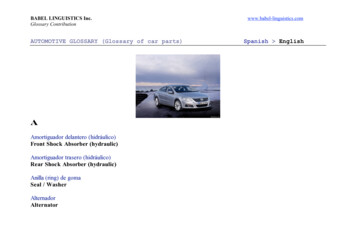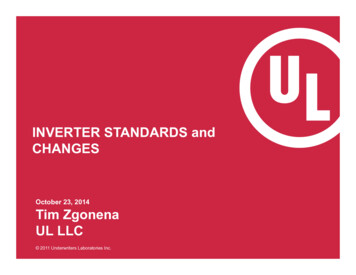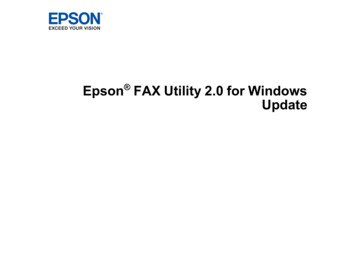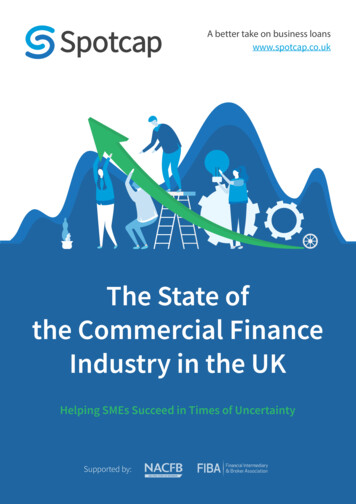
Transcription
FAI's Public Utility Finance and Accounting SeminarsSeminars for Professionals Concerned with Electric, Gas and Water CompaniesFinancial Accounting InstituteP.O. Box 118Tenafly, NJ 07670www.financialaccounting.comPhone 201-568-0249Glossary of Utility Finance and Accounting Terms used in our SeminarsLetters in parenthesis, preceding the definition, identify the sources used in compiling the glossary. A list of these sources is at end.abandonment(U) Retirement of a utility plant, on the books, without its physical removal from its installed location.above-the-line(U*) Revenue or expenses, incurred in operating a utility, that are included in the ratepayer’s rates.above-the-line expensesComponents of a utility's Statement of Income that appear above the Operating Income line. They include expenses that are attributable to thefurnishing of utility service and are therefore taken into account in determining rates. Although the Cost of Capital (interest on debt and incomefor shareholders) is indcluded in rates, it is done for investor owned utilities indirectly via the rate base.accelerated depreciation(A) Any method of calculating depreciation charges where the charges become progressively smaller each period. Examples are doubledeclining-balance and sum-of-the-years'-digits methods.accelerated method (of depreciation)Larger depreciation expense in earlier years and smaller depreciation expense in later years.accounting period(A*) The time period for which financial statements that measure flows, such as the income statement and the statement of cash flows, areprepared. Could be a month, a quarter of the year or a year.
Accounting Standards Codification (ASC)(B2) Financial Accounting Standards Board (FASB) Accounting Standards Codification (ASC) On July 1, 2009, the FASB ASC replaced allpreviously existing financial accounting standards, (other than U.S. Securities and Exchange Commission pronouncements), to become thesingle source of authoritative nongovernmental U.S. generally accepted accounting principles (GAAP).accrual accounting(A*) The method of recognizing revenues and expenses. As goods are sold (or delivered) and as services are rendered, independent of the timewhen cash is received. Expenses are recognized in the period when the related revenue is recognized, independent of the time when cash ispaid out. Contrast with the cash basis of accounting.accumulated other comprehensive incomeIncome items that bypass the income statement.acquisition adjustment(D*) When one rate-regulated utility buys plant from another regulated utility. This is the difference between the cost of acquiring an operatingunit or system and the depreciated original cost of the acquired property.additional paid in capital (APIC)(J) Excess received from stockholders over par value, or stated value, of the stock issued: also called contributed capital in excess of par.adjustment clause(E*) Provision in a rate schedule that provides for an adjustment to the customer's bill if the cost of some item varies from the amount included inthe tariffed rate. This is done without a rate case, but possibly with a limited reasonableness review by the regulator. These adjustment clausesare also called trackers, riders, flow through items, or balancing accounts.advances for construction(G*) Refundable payments usually received from ratepayers or real estate developers to help finance utility plant construction. They are in effect,interest-free loans. Since they are not provided by investors, they are commonly subtracted from the rate base.adverse opinion(A) An auditor's report stating that the financial statements are not fair or are not in accord with GAAP.AFUDC(F*) Allowance For Funds Used During Construction A noncash item representing the estimated composite interest costs of debt and therequired return on preferred and equity funds used to finance construction. The allowance is included in the CWIP accounts and income. Thisportion of the carrying value of property (along with the rest) is included in a utility company's rate base and is recovered through depreciation inrates.allowed rate of return or allowed return(P*) The rate of return, (to be applied to rate base), which the regulatory commission sets in determining rates.
American Recovery and Reinvestment Act of 2009The Act includes federal tax cuts, expansion of unemployment benefits and other social welfare provisions, and domestic spending in education,health care, and infrastructure, including the energy sector. Also called the stimulus bill.amortization(A*) The general process of allocating acquisition cost of assets to either the periods of benefit as expenses or to inventory accounts as productcosts. Called depreciation for plant assets, depletion for wasting assets (natural resources), and amortization for intangibles. The term is alsoused for the reduction of some liabilities i.e., amortization of a loan.APICSee: additional paid in capitalAROSee: asset retirement obligationsarrearageFor a bond or preferred stock dividend -- overdue interest or dividend.ASCSee: Accounting Standards Codificationasset retirement obligations (ARO)(W1*) Asset Retirement Obligations are liabilities shown under GAAP, when removal of plant is required by law or contract.auditor's report(A) The auditor's statement of work done and an opinion on the financial statements. Opinions are usually unqualified ("clean"), but may bequalified, or the auditor may disclaim an opinion in the report. Often called the "accountant's report." See adverse opinion.authorized return on equity(U1*) Commissions authorize a utility to set rates that allow the utility an opportunity to earn a reasonable return on its shareholders’ equityinvestment (ROE). The standard is that the overall rates of a utility must provide the company with a reasonable opportunity to attract capital andearn a fair return on its investments.balance sheet(A) Statement of financial position that shows total assets total liabilities owners' equity.balancing accountsRegulatory Assets or Regulatory Liabilities which reflect amounts due from, or due to, customers through adjustment clauses.base rates(E*) Portion of the utility rates covering the costs of providing service (including profit) that result from a rate case and may be changed byadjustment clauses.
below-the-line(D*) All income statement items of revenue and expense not included in determining operating income. If the item falls below the net operatingincome line of the income statement, it is labeled a below-the-line item. Operating income is the “line" referred to. These items are usually notincluded directly in the ratepayers’ rates (although some are included indirectly; for example interest expense is included in rates through thereturn on rate base).bond ratings(A*) Ratings of corporate and municipal bond issues by Moody's Investors Service, Fitch and Standard & Poor's Corporation, or other such bondrating agencies.book value(A*) The amount shown in the books (or in the accounts) for an asset, liability, or owners' equity item. Generally used to refer to the net amountof an asset or group of assets shown in the account, which records the asset and reductions, such as for depreciation or amortization, in its cost.For a company as a whole, the common stockholder’s equity usually expressed on a per share basis.budget and control reportAn internal report for managers, showing budgets versus actual costs.business risk profileA concept used by S&P in rating bonds.CACSee: customer advances for constructioncapital leaseSee: financing lease.capital budget(J) Plan of proposed acquisitions and replacements of long-term assets and their financing.capital budgeting(J) Process of making long-term planning decisions for capital investments. Capital budgeting decisions are a key factor in the long-termprofitability of a company.capital market(B) Financial market (particularly the market for long-term securities).capitalization(B) Long-term debt, preferred stock, and owners' equity.capitalization ratio(E) Percentage of Long-Term Debt, Preferred Stock, Preference Stock, and Common Stock Equity (or their components) to Total Capitalization.
cash flowHas many definitions. The cash flow on the financial statements is the Cash from Operating Activities.cash flow analysisUsually refers to a present value of future cash flows analysis.cash from financing activities(J) Cash obtained from transactions including the distribution, acquisition, movement and management of money.cash from investing activities(A2*) Cash obtained from purchases and sales of long-term investments and plant. The title of one section of the statement of cash flows in thefinancial statements.cash from operations (cash from operating activities)(J*) Cash arising from the ongoing operations of the business for the accounting period. The title of one section of the statement of cash flows inthe financial statements.CIACSee: contributions in aid of constructioncommon stock(A) Stock representing the class of owners who have residual claims on the assets and earnings of a corporation after all debt and preferredstockholders' claims have been met.construction work in progress (CWIP)Plant under construction at a regulated utility. Also refers to a method of ratemaking where the CWIP is rate base.contributions in aid of construction (CIAC)(D*) Nonrefundable donations or contributions in cash or properties from individuals, governmental agencies or others for construction orproperty-addition purposes, usually the associated plant does not become part of the rate base on which the utility may earn an approved return.cost(A) The sacrifice, measured by the price paid or required to be paid, to acquire goods or services. The term "cost" is often used when referring tothe valuation of a good or service acquired. When "cost" is used in this sense, a cost is an asset. When the benefits of the acquisition (thegoods or services acquired) expire, the cost becomes an expense or loss.cost based regulationAnother name for cost of service regulation.cost of capital(D*) The composite rate of cost for debt interest, preferred stock dividends and common stockholder return requirements. It is the composite ofthe cost of the various capital sources used to finance the assets utilized in supplying utility service.
cost of equityThe required rate of return for the equity holder, appropriate for the risk of this investment.cost of preferred capitalThe required rate of return for the preferred stockholder.cost of service (often referred to as “revenue requirement")(F*) Operation and maintenance expenses, depreciation and amortization expenses, and income and other taxes found “just and reasonable” bythe regulatory agency for rate-making purposes, plus an allowed return (usually computed by applying a rate of return to the rate base).cost of service study(E*) An analysis used as the basis for designing rate schedules. This concept attempts to correlate utility costs and revenues with the serviceprovided to each of the various customer classes in the rate design or rate structure phase of a rate case.cost of service regulation(S*) The traditional utility regulation under which a utility’s rates are set based on the cost of providing service to customers. Also called rate ofreturn regulation or rate base regulation.cost recovery ratesCosts that are recovered from ratepayers, through adjustment clauses, with no return.cost structure(A1*) The expenses that a firm must take into account when manufacturing a product or providing a service. Types of cost structures includetransaction costs, sunk costs, marginal costs and fixed costs. The cost structure of the firm could also refer to the ratio of fixed costs to variablecosts.cost-plus (cost plus pricing)(J*) Clear and convenient way to establish a selling price. A supplier seeking to avoid the uncertainty associated with predicting costs may usethis method in determining a contract price. The plus usually refers to profit.CPI (Consumer Price Index)(J) Measure of price level computed by the Bureau of Labor Statistics on a monthly basis. The ratio of the cost of specific consumer items, in anyone year, to the cost of those items in the base year.creative accounting(J*) Management's attempt to "fool around" with its accounting in order to overstate net income, understate liabilities or manipulate some otherfinancial figures.current cost of capitalToday’s cost of debt and preferred as distinguished from the embedded cost.
current maturities(E*) Securities that will be due and payable within one year from the balance sheet date. For balance sheet presentation, they are usuallyincluded in Current Liabilities.customer advances for construction (CAC)(E*) A liability representing cash advances paid to the utility by customers, requiring the construction of facilities in their behalf. These advancesare refundable. The time or extent of refund is dependent on the contract provisions of the advance (usually dependent on whether or not, duringa specified period, the revenue from the installation warrants the refund). CWIPSee: construction work in progressDCFSee: discounted cash flowdebt ratio(E*) Percentage of total capital (or capitalization) that is borrowed.debt serviceCash outlay needed to meet principal and interest payments on debt.declining balance depreciationThe method of calculating the periodic depreciation charge by multiplying the book value at the start of the period by a constant percentage.decommissioning(E*) Removal of a generating facility from service.decouple (decoupling)(N3) A ratemaking technique that separates the amount of a commodity sold from the total revenues (or profits) expected from those sales. Thistechnique is often recommended for use in the energy industry by conservationists since it provides a means of removing the incentive thatutilities have to sell more energy to increase earnings.default(E) Failure to fulfill a contract; specifically, failure to make timely payment of interest or principal on a bond or otherwise comply with any provisionof the indenture.deferred cost(A) Expenditure not recognized as an expense of the period when made but carried forward as an asset to be written off in future periods, suchas for advance rent payments or insurance premiums.deferred tax assetAn asset created by temporary differences between GAAP and Tax Methods or estimates. See: deferred tax liability
deferred tax liability (deferred income tax liability) (deferred taxes)(S*) A liability on the balance sheet representing the additional income taxes that would have been due if a utility had not been allowed tocompute tax expenses differently for income tax reporting purposes than for financial statement purposes. Results from temporary tax bookdifferences.demand side management (DSM)(E) Planning, implementation, and monitoring of utility activities designed to influence customer use of electricity in ways that will produce desiredchanges in a utility's load shape (i.e., changes in the time pattern and magnitude of a utility's load). DSM includes only those activities that involvea deliberate intervention by the utility to alter the load shape.depreciation(A1*) Fixed assets, plant assets, plant, equipment, etc. are assets that will not last indefinitely. During each accounting period (year, quarter,month, etc.) a portion of the cost of these assets is being “used up”. The portion being used up is reported as depreciation. In effect, depreciationis the transfer of a portion of the asset’s cost from the balance sheet to the income statement during each year of the asset’s life.depreciation lifeLife estimate used to determine depreciation expense.deregulation(G*) Process of removing a utility's activities or a portion of its activities from regulation. Occurs when changing conditions, such as competition,make cost-based regulation no longer feasible.derivatives(R*) Financial contract whose value is derived from publicly traded securities, commodity costs, interest rates, currency exchange rates, ormarket indexes or some other underlying price.disallowance of costs(G*) When incurred costs are not considered necessary to providing utility service, or are not prudently incurred or are not of any benefit to theratepayers and are therefore not recoverable in rates.discount rate(A*) Interest rate used to convert future cash flows to present values.discounted cash flow (DCF)A method of estimating the cost of equity capital. The formula is K (d/p) g.Also, a finance technique for estimating the present value of future cash flows.dividendA distribution of earnings to owners of a corporation; it is usually paid in cash.dividend yield(A*) Dividends per share for the year, divided by market price of the stock as of a given time of the year.
double declining balance depreciation(A) Declining balance depreciation, where the constant percentage used to multiply by book value in determining the depreciation charge for theyear is 2/n and n is the depreciable life in periods.DSMSee: demand side managementDTASee: deferred tax assetEAC (Energy Adjustment Clause)See: energy adjustment clauseearnings(A) Income, or profit. Also called Net Income, Net Earnings or Net Profitearnings before taxCommonly used expression for earnings before income taxes but after other taxes are subtracted.earnings per share of common(G*) Net earnings of the firm, divided by the average number of common shares outstanding during the period.EBITDA (Earnings Before Interest, Income Taxes, Depreciation and Amortization)(B1*) A financial measure defined as revenues less cost of goods sold; and selling, general, and administrative expenses. In other words,operating and nonoperating profit before the deduction of interest and income taxes. Depreciation and amortization expenses are not included inthe costs.earnings per share of common(G) Net earnings of the firm, after income taxes and preferred dividend requirements, divided by the average number of common sharesoutstanding.EBITDASee: earnings before interest, income taxes, depreciation and amortizationeconometrics(R) Economic modeling technique that seeks to explain in mathematical terms the relationships between key economic variables such as capitalspending, wages, bank interest rates, population trends, and also government fiscal and monetary policies.ERTASee: Economic Recovery Tax Act of 1981ESOP (Employee Stock Ownership Plan)(E) Defined contribution plan to encourage employee ownership of business enterprises.
equity return requirementCost of equity capital.essential serviceOne criterion for the need to regulate rates. The utilities are generally assumed to be providing an essential service.excess deferred taxesDeferred taxes, which have been collected from ratepayers through the normalization method, for which the tax rate is now lower. Usually thecommission has taken action to return these amounts to ratepayers.expenseA cost needed to get revenue during the accounting period.FAIPSOur simple example utility company -- “Financial Accounting Institute Public Service”fair valueMarket value.FASBSee: Financial Accounting Standards BoardFederal Power Commission(L) Agency empowered to regulate the interstate energy industry; became the Department of Energy (DOE) on October 1, 1977.FERC (Federal Energy Regulatory Commission)(E) Independent agency within the Department of Energy. FERC is vested with broad regulatory authority. Virtually every facet of electric andnatural gas production, transmission, and sales conducted by private investor-owned utilities, corporations or public marketing agencies is placedunder the commission's purview through either direct or indirect jurisdiction, if any aspect of their operations are conducted in interstatecommerce.FERC USOA (Federal Energy Regulatory Commission) (Uniform System of Accounts)(U*) FERC list of accounts for the purpose of classifying accounting information associated with a utility's operations. The USOA specifies anumber for each account, together with a title and a description of content, and prescribes the rules and regulations governing the use of suchaccounts.FFO (Funds From Operations)One of many measures of Cash Flow which is typically defined as working capital.FIFO(A) First-in, first-out; an inventory flow assumption by which ending inventory cost is determined from most recent purchases, and cost of goodssold is determined from oldest purchases including beginning inventory.
Financial Accounting Standards Board (FASB)(A) Financial Accounting Standards Board. An independent board responsible, since 1973, for establishing generally accepted accountingprinciples in the U.S.financing lease (finance lease)(A) A lease treated by the lessee as both the borrowing of funds and the acquisition of an asset to be amortized. Both the liability and the assetare recognized on the balance sheet. Expenses consist of interest on the debt and amortization of the asset.flow throughA method of measuring income tax expense for ratemaking which measures the income tax expense as the tax due for the year.Also: To pass through to ratepayers some item covered by an adjustment mechanism.flow through costsCosts passed through to ratepayers through adjustment clauses.See: cost recovery rates.formula ratemakingA ratemaking methodology used by the FERC to change rates each year without a rate case. Term is used by some states in a different sense.four sets of booksThe four major uses of accounting data. The four major places where we use accounting data: GAAP; Tax; Rates, and Managerial.free capitalIn ratemaking, liabilities which have no interest associated with them. Examples are accounts payable and deferred taxes due to thenormalization method.free cash flowCash from operations less preferred dividends and capital expenditures.free financingSee: free capital.fuel adjustment clause(G*) Mechanism that passes the actual cost of fuel through to the consumerGAAP(A) Generally Accepted Accounting Principles.(G*) Principles, rules, procedures, and conventions of accounting practice, used for preparing financial statements. Defined by a hierarchy of rulemaking authorities and promulgated by various types of pronouncements. Subject to change as economic circumstances change.
goodwill(A) The excess of cost of an acquired firm, over the current or fair-market value of net assets of the acquired firm.gross upIn ratemaking, the concept that in order to get enough extra revenue to cover higher expenses these expenses must be increased by dividingthese expenses by 1 minus the tax rate.IFRSSee: International Financial Reporting Standardsimpaired assetAsset which is reduced on the balance sheet according to GAAP rules.impairmentThe process of reducing an asset on the balance sheet according to GAAP rules.incentive ratemakingAny type of ratemaking which gives the company an incentive to operate differently.See: PBR.income from continuing operations(A*) As defined under GAAP all revenues less all expenses except for the following: results of operations, including income tax effects, that havebeen or will be discontinued; gains or losses, including income tax effects, on disposal of segments of the business; gains or losses, includingincome tax effects, from extraordinary itemsincome statement(A) The statement of revenues, expenses, gains, and losses for the period ending with net income for the period.income tax accountingAccounting on the tax “set of books”.income taxes(J*) Government levy on the taxable income of an individual, corporation, or other taxable unit.incremental analysis(I*) Form of analysis; which considers all the incremental cash flow impacts of a proposed action.incremental cash flowMore or less cash flows due to a decision.incremental costIncrease in cost above some previously determined base amount.
inelastic demand(X) Of, or relating to, the demand for a good or service when quantity purchased varies little in response to price changes in the good or service.intercompany profits(J*) Income from goods or services sold to a related company when consolidated financial statements are being prepared. Only earningsapplicable to the sales outside of the consolidated entity are recognized.interest capitalizationInterest included in plant cost.Intergenerational EquityConcept used in ratemaking, refering.to the fairness of costs included in rates over a period of years.International Financial Reporting Standards (IFRS)(W1) Standards, Interpretations and the Framework adopted by the International Accounting Standards Board (IASB).interperiod tax allocation(H*) Accounting procedures that account for temporary differences between GAAP and tax.intraperiod tax allocationAssociating income taxes with different categories of income within the same accounting period. For example, extraordinary items have their taxeffect shown along with the gain or loss.investment grade(R) Description of a high-quality corporate or municipal bond, assigned a rating of AAA to BBB by Standard & Poor’s and Fitch’s InvestorsService (Moody’s Investors Service assigns ratings of Aaa and Baa, respectively.)investment tax credit (ITC)(A*) A reduction in income tax liability granted by the federal government to firms that buy new equipment. This item is a credit, in that it isdeducted from the tax bill, not from taxable income. The tax credit has been a given percentage of the purchase price of certain assetspurchased. The actual rules and rates have changed over the years.investor-owned utility (IOU)(E*) Utility organized as a tax-paying business usually financed by the sale of securities. Usually a corporation or partnership.investors(V) Party who puts money at risk; may be an individual or an institutional investor.IOUSee: investor owned utility
ITC (Investment Tax Credit)See: investment tax creditLBO (leveraged buyout)(J) Acquisitions of one company by another, typically with borrowed funds. Usually, the acquired company's assets are used as collateral for theloans of the acquiring company.lessee accountingAccounting by the lessee for leased assets.liability methodThe GAAP method of accounting for temporary “tax-book” differences.LIFO(A) An inventory flow assumption where the cost of goods sold is the cost of the most recently acquired units and the ending inventory cost isdetermined from costs of the oldest units; contrast with FIFO.loadA word used in the electric and gas business for demand.load factor(E) Ratio of the average load in kilowatts supplied during a designated period to the peak or maximum load in kilowatts occurring in that period.long term debt (LTD)(E) Includes outstanding mortgage bonds, debentures, advances from associated companies, and notes that are due one year or more from dateof issuance.long-lived asset(A) An asset whose benefits are expected to be received over several years. A non-current asset, usually includes investments, plant assets,and intangibles.LTDSee: long term debtMACRSSee: modified accelerated cost recovery systemmaintenance costs (maintenance expenses)(E*) A subdivision of Operating Expenses; includes labor, materials, and other direct and indirect expenses incurred for preserving the operatingefficiency or physical condition of plant.
managerial accounting(J) Process of identification, measurement, accumulation, analysis, preparation, interpretation, and communication of financial information that isused by management to plan, evaluate and control within an organization. It is concerned with providing information to internal managers, whoare charged with directing, planning, and controlling operations and making a variety of management decisions.marginal cost of capital(W) The cost of an additional dollar of new funds.market price(U) Price determined in competitive markets.market value(E) Current or prevailing price of a security or commodity as indicated by current market quotations, and therefore the price at which additionalamounts presumably can be purchased or sold.mass property accountingAlso call group deprecation. A method of depreciation which does not account for each component piece of plant but averages groups of planttogether. Usually no gains nor losses are show for retirement of plant.MISO (Midwest Independent Transmission System Operator)(M) Independent, nonprofit organization that was approved as the nation's first regional transmission organization in 2001, serving 13 U.S. statesand the Canadian province of Manitoba.modified accelerated cost recovery system (MACRS)(E) In the United States, tax depreciation on property placed in service after 1986, using accelerated methods over statutory life estimates.monopoly(E) Exclusive control of a commodity or service in a given market, or control that makes possible the fixing of prices and the virtual elimination offree trade.Moody's (Moody’s Investor’s Service)(E) One of the principal bond rating agencies.NASDAQ(T) Acronym for National Association of Securities Dealers Automated Quotations. It is a subscription computerized service, owned by theNational Association of Securities Dealers (NASD).National Energy Board (NEB)(N1) The National Energy Board (NEB or Board) is an independent federal agency established in 1959 by the Parliament of Canada to regulateinternational and interprovincial aspects of the oil, gas and electric utility industries.
net book value(N) Recorded cost of an asset or group of assets minus the accumulated provision for depreciation of these assets.net income (net earnings)(A) The excess of all revenues and gains, for a period, over all expenses and losses of the period.net present value(A) Discounted or present value of all cash inflows and outflows of a project or from an investment at a given discount rate.net profit (net income)See: net income.non-discounted cash flowsNominal amounts of cash flows in the future.non-investment gradeA bond wh
FAI's Public Utility Finance and Accounting Seminars Seminars for Professionals Concerned with Electric, Gas and Water Companies Financial Accounting Institute P.O. Box 118 Tenafly, NJ 07670 www.financialaccounting.com Phone 201-568-0249 Glossary of Utility Finance and Accounting Terms used in our Seminars










